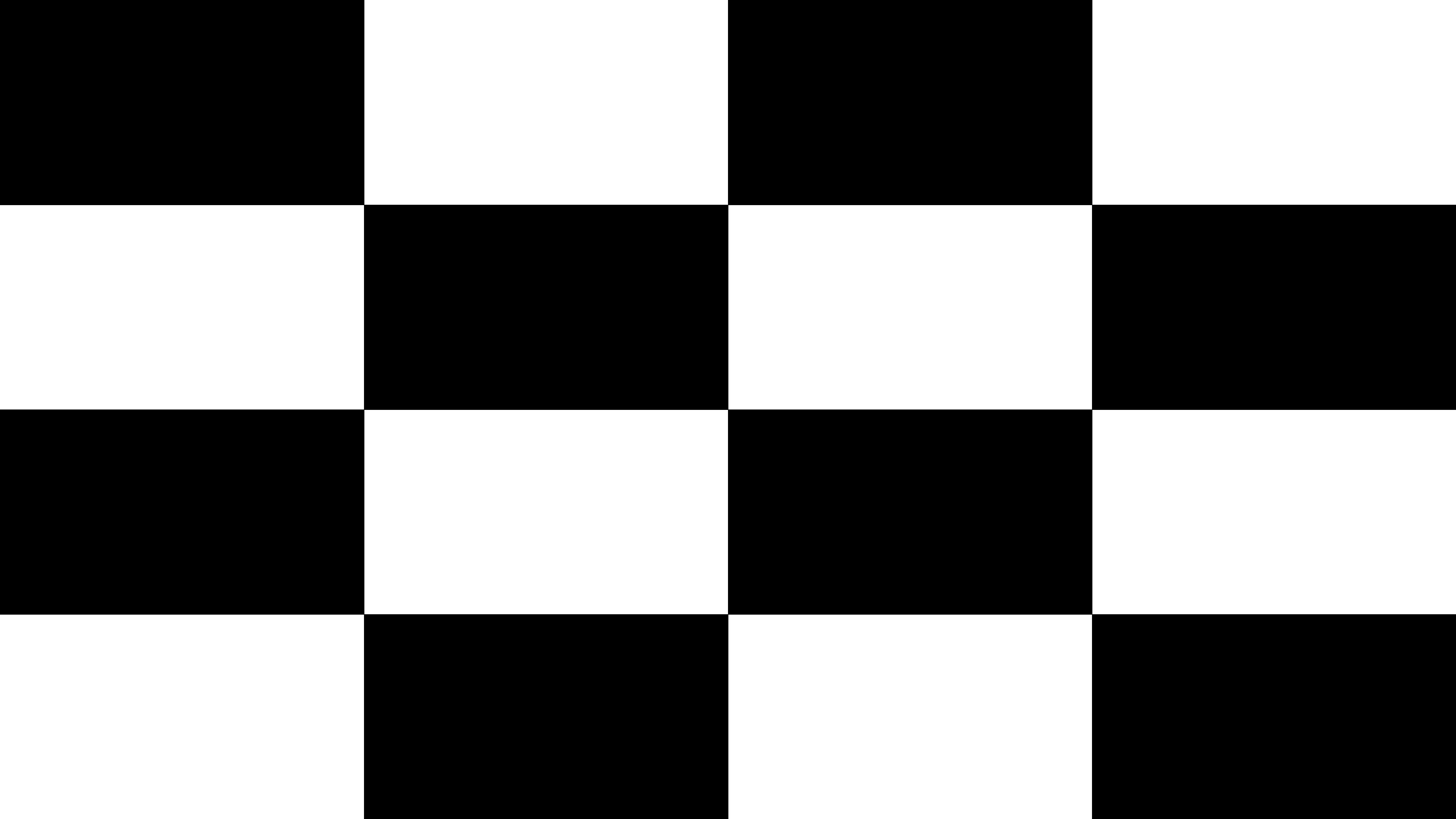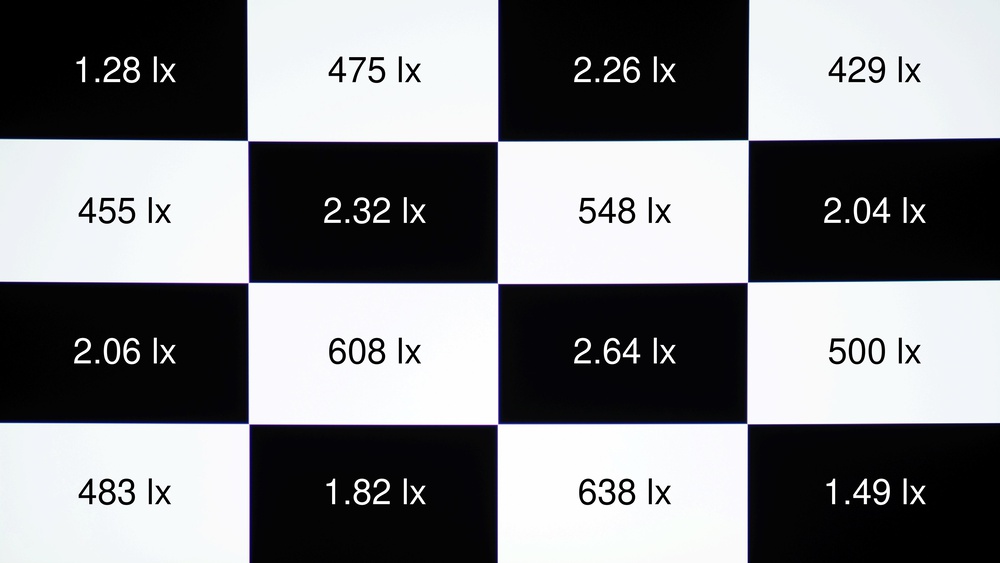- 20.0%1% APL Native Contrast
- 20.0%5% APL Native Contrast
- 20.0%10% APL Native Contrast
- 20.0%15% APL Native Contrast
- 10.0%25% APL Native Contrast
- 10.0%50% APL Native Contrast
The contrast ratio of a projector is the ratio between the illuminance of the brightest whites and the darkest blacks that a projector can produce simultaneously. Higher contrast results in a greater illuminance difference between the deepest blacks and the brightest whites, so shadow details and dark areas of the screen remain dark when bright highlights are visible. A projector with a low contrast ratio looks washed out whenever bright highlights are in the scene.
To test the contrast, we measure the average illuminance of multiple white and black squares at six different average picture levels (APL) and then calculate the ratio between the two. Illuminance is a metric to measure the amount of light (or intensity) falling on a given surface and is expressed in cd/m². This gives us a contrast value at each APL level, showing us how well the projector handles blacks as the image increasingly gets brighter.
Test results
When It Matters
Contrast is one of the most important aspects of picture quality with any display technology. Whether you're looking at a TV, projector, monitor, or even your phone, the display's contrast is usually one of the first things most people will notice. It's especially important if you're watching something in a dark room. Contrast isn't just about deep blacks or bright whites but the difference between them. If you're watching a movie in a dark room on a projector with low contrast, whites and saturated colors won't stand out well, and the entire image looks dull and flat. High contrast leads to a punchier image, with shadow details that stand out from the dark and bright highlights that stand out from the background.
It's important to note that contrast measurements on a 50% APL checkerboard pattern, which is how the industry standard ANSI contrast is measured, don't paint the full picture of the projector's performance. Many factors go into producing good picture quality from a projector, including the room setup, ambient light, and even the specific screen you're using. The content also plays a big role here, as a scene's average picture level (APL) can greatly impact the perceived contrast. This is why we now measure contrast at different APLs, as simply measuring contrast on a 50% APL checkerboard doesn't tell you how the projector will perform in lower APL scenes. The lower the APL, the higher the effective contrast ratio. This is due to light leakage within the projector's optical setup, so more light going through means more light leakage and lower contrast. It's also because the more light the projector emits, the more light is reflected from your viewing environment onto the screen, again lowering perceived contrast. Thus, by measuring contrast at different APLs, we can paint a clearer picture of how the projector performs in many scenes, from very dark to brighter ones.
Our Tests
The way we measure contrast is fairly simple. Using a checkerboard pattern of alternating full white and full black squares or circles, we measure the illuminance of each and calculate the ratio between them. We repeat this process at six different APL levels: 1%, 5%, 10%, 15%, 25%, and 50%, for 96 total measurements. This process, when done with a 50% slide, is usually called ANSI contrast. However, our pattern and test methodology differ slightly from the commonly used ANSI test methodology.
Once we've measured the black and white, we can calculate the contrast ratio. To get this number, we divide the white illuminance by the black illuminance.
Native Contrast
The native contrast test measures the ratio of the projector's white and black brightness in its most accurate, post-calibration settings, with all dynamic contrast features, like iris dimming, turned off. Since it's a ratio, there's no unit for contrast. Instead, contrast is expressed as 'X:1,' with 'X' being how many times brighter white is than black. For example, a 300:1 contrast ratio would mean that the projector emits a white that's 300 times brighter than its black. The higher the contrast ratio, the deeper the blacks, and the better the picture will look.
We set up the projector in our completely black, light-controlled room to run the test. We're using a 100" Stewart StudioTek 100 projector screen with neutral gain (1.0), with the lights turned off in the room. We connect the projector to a computer, which we then use to display the six APL checkerboard patterns. We measure the illuminance of each white and black square or circle using a Konica Minolta LS-100 Luminance Meter, which is expressed in lux, and record it. We take multiple measurements to ensure our results are consistent and not impacted by stray reflected light.
Looking at the two examples above from our 0.8 test bench, you can clearly see the difference between a projector with low contrast (left) and one with high contrast (right). Combined with the low peak brightness of the KODAK LUMA 150, the overall picture quality is disappointing, and bright highlights don't stand out at all. White doesn't even really look white. The Optoma UHD35, on the other hand, has bright, punchy whites, and the colors are sharp and stand out immediately, even in scenes with lots of dark elements.
To arrive at a final contrast measurement, we take the average of the white squares and divide it by the average of the black squares. We also take a picture of the checkboard pattern on the screen and overlay our measurements on the image to give you a sense of the black-and-white illuminance uniformity across the screen.
Alternative Methods
You'll likely notice that our measured contrast rarely matches manufacturer claims. Why is that? Well, there are multiple ways to measure contrast, and those sneaky manufacturers often choose the method that delivers the highest numbers for their marketing. Not all manufacturers do this, but most do. So what other ways are there? When you see numbers like 1,500,000:1, the manufacturer most likely uses a full white and full black square to measure contrast. The problem with this method is that it simply doesn't match any real-world content. The checkboard pattern above doesn't really match real content, but it's a much more complicated pattern for any display technology, so it more closely matches your real-world experience.
ANSI Contrast
Measuring contrast with a 50% APL slide is commonly called "ANSI Contrast." Before the test bench, we also measured contrast solely with a 50% APL slide, but our methodology wasn't quite in line with the ANSI standards, so we called it Native Contrast instead. Contrast measurements are extremely sensitive to stray light measurements. As our Projector Launch article explained, during our initial test development process, we discovered that even our clothing can significantly impact our measurements! Although we've taken steps to reduce reflections and stray light, our test setup with a 50% APL slide isn't good enough to be considered equivalent to ANSI contrast. Our test room resembles a typical dark-room projector setup you might have at home, but it's not as good as a true laboratory setup. This means our results with a 50% APL slide will almost always be worse than true ANSI contrast measurements.
FOFO
Another common method to measure contrast is known as FOFO, or Full-On, Full-Off. As the name suggests, this method to measure contrast uses a full white screen followed by a full black screen. This way of measuring contrast is one of the most misleading, as it's usually a lot easier for a projector (or any display) to show a full white screen or a full black screen. This rarely resembles anything remotely close to real content, so it's extremely misleading and not worth considering. Many projectors can do really well with this test yet have poor real-world contrast.
Dynamic Contrast
Many projectors include features that help improve contrast by adjusting the light output from the projector. For example, some projectors can adjust the iris when displaying a dark scene, reducing the amount of light they send. When measuring FOFO contrast in particular, these features can significantly improve the measured contrast, as they can effectively close the iris entirely when displaying a full dark screen. Brands often use dynamic contrast when marketing their projectors, as this method frequently yields the highest contrast measurements of any methodology. The problem with this method is that it rarely comes anywhere near the actual contrast capabilities of the projector, so it doesn't represent what you'll see when watching real content.
Conclusion
Contrast is one of the most important, most noticeable aspects of the overall picture quality of a projector. The higher the contrast, the better, as bright highlights will stand out better from darker areas of the scene. Although there are multiple ways to test for contrast, we use a checkerboard pattern and measure the difference in the average illuminance between the white and black squares.



